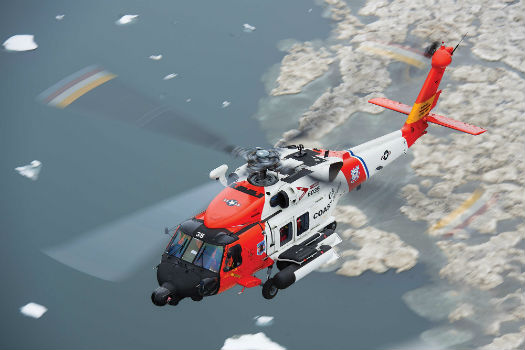
Search-and-rescue (SAR) missions are typically emotional and very demanding operations. Lives are at stake, often in remote and treacherous environments, where the chances of survival lessen with every tick of the clock. Airborne search assets routinely devote hours, even days, to long and monotonous search missions, across large swathes of ocean or expansive landscapes, challenging the endurance of man and machine. And not only can these missions be mentally and physically fatiguing for flight crews, there’s also a hefty price tag associated with keeping assets airborne.
Recently, however, an exercise in one of the most remote and challenging environments in the United States explored an innovative application of technology that may enhance the overall effectiveness of future SAR missions around the world. The location was Deadhorse, a small community in Alaska’s North Slope Borough that typically serves as a gateway to the nearby Prudhoe Bay oilfields. Covering 95,000 square miles (about 246,000 square kilometers), the borough is both the largest county-level political subdivision in the United States by area (and larger than 39 states), and the country’s northernmost municipal government. Located far north of the Arctic Circle, the climate in this part of the world is unforgiving for much of the year, with temperatures reaching -55 C (-67 F) with the wind chill in the middle of a winter where the sun remains below the horizon for more than 60 days. In these conditions, the speed with which search-and-rescue missions are conducted really does make the difference between life and death.
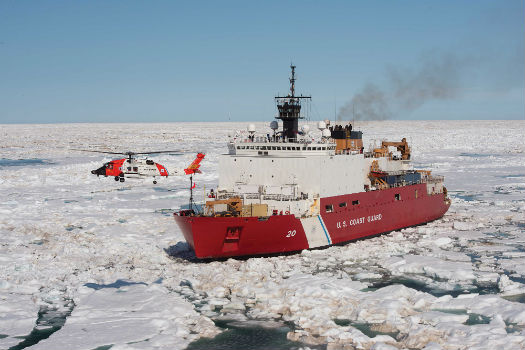
As North Slope does not have the reliable communication infrastructure, satellite coverage or emergency response assets typically found in the lower latitudes, individual local assets in the region — both civilian and governmental — must work together to fulfill this critical need for the borough’s population, as well as for the many hundreds of transient workers supporting the oil-and-gas industry in the region.
It was with this in mind that the U.S. Coast Guard (USCG), along with representatives from ConocoPhillips, the U.S. Department of Energy, Sandia National Laboratories, the Federal Aviation Administration (FAA), the North Slope Borough, Era Helicopters and Priority 1 Air Rescue descended upon Deadhorse to take part in the Arctic Technology Evaluation 2015 Search and Rescue Exercise. The goal was to identify the benefits of combining manned and unmanned aerial vehicles (UAVs) in remote area SAR missions, and demonstrate their combined capabilities and interoperability.
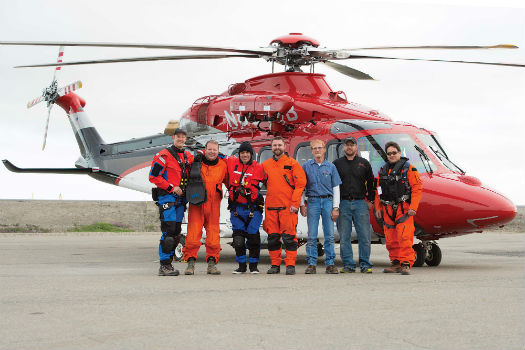
Era’s involvement was due to a combination of several factors, including well established relationships with ConocoPhillips (which owned the certificate of authorization to operate the UAV in the airspace) and the USCG, as well as its work on a similar demonstration of marine-based UAV and helicopter SAR in the Gulf of Mexico.
“The Coast Guard, across the board, is a huge fan of forming partnerships, and is always trying to find the best solution to the problem using those partnerships and using each other’s skill sets,” Lt Joe Plunkett, who piloted a USCG MH-60T during one of the exercises, told Vertical. “We have a lot of entities [on the North Slope] and the real solution is trying to build healthy partnerships and . . . really effect the end game, which is public safety.”
A Unique Team
The exercises were held over two days in a block of FAA special-use airspace off the coast of Deadhorse. The aviation assets taking part included Era’s AgustaWestland AW139 (with Priority 1 supplying its hoist rescue crew), the USCG’s Sikorsky MH-60T, and two UAVs — the Boeing-Insitu ScanEagle, and the AeroVironment RQ-20A Puma.
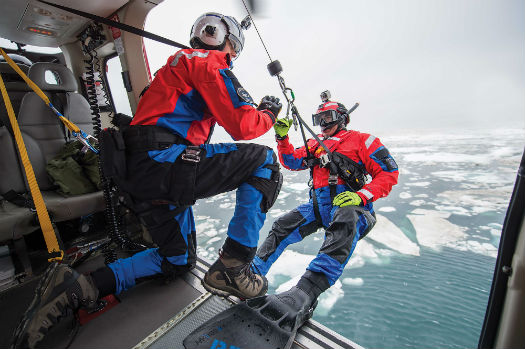
The ScanEagle has a wingspan of over 10 feet, is powered by a two-stroke piston engine, and has an endurance of over 20 hours. The smaller battery-powered Puma has limited endurance, but is more economical. The aircraft can be equipped with electro optical and/or infrared cameras capable of streaming video to remote ground monitors, and can be controlled remotely by an operator at a ground control station, or autonomously with pre-programmed flight parameters. Each can then be recovered remotely aboard a ship, or at a land-based station. Both UAVs have been certified by the FAA to fly in U.S. airspace for commercial purposes, and had been used prior to the exercise for other Arctic observation and research missions.
The USCG Cutter Healy, the United States’ newest and most advanced icebreaker, initiated the exercises, which were designed to simulate an offshore emergency. Two targets were deployed and set adrift in the current — a bright orange six-person life raft, and a floating human form with an emitting heat source (which made it detectable to infrared) dubbed “Thermal Oscar.”
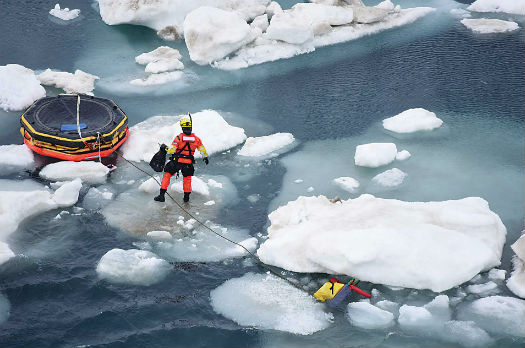
“This exercise is intended to test the operation of an unmanned vehicle, whether it was launched from land or launched from sea, to search for us, acquire a position, and relay that position back to a land asset so they can come and effect a rescue,” said Plunkett.
For each exercise, a single UAV was launched from Oliktok Point, an onshore U.S. Air Force and climate research installation. They flew designated courses as stipulated by FAA regulations until reaching the search area, about 20 miles offshore. Control of the UAVs was then passed to UAV operators aboard the Healy to perform the search.
While the UAV searched far offshore, helicopter flight and rescue personnel from the USCG and Era/Priority 1 met to hold a pre-mission brief and discuss each aircraft’s role and responsibilities.
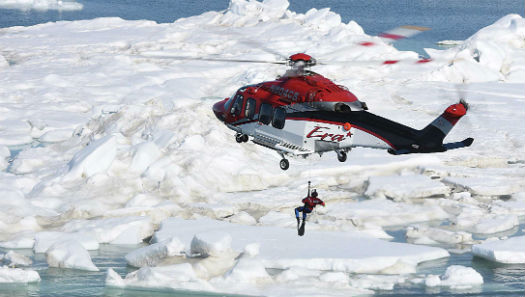
The Era pilots and Priority 1 crew had been temporarily reassigned to the exercise from their usual SAR assignment in the Gulf of Mexico. Pilot Dave Merriman had a background as a USCG pilot, so the Arctic environment was a familiar setting. However, his partner, Noah Cowen, was a bit out of his element, being accustomed to a much warmer climate. “The whole environment up here is obviously much different than the Gulf of Mexico,” said Cowen. “But we got a great area briefing from our counterparts who are based here, so I felt very comfortable going out offshore and into the ice.”
Combining Expertise
Once the UAVs had located the targets, the operators relayed precise location information to the two manned aircraft, which were standing by on the ground in Deadhorse. “Our mission was not to just go out to a latitude and longitude, but to go specifically to a point that had been acquired by the unmanned vehicle,” said Plunkett.
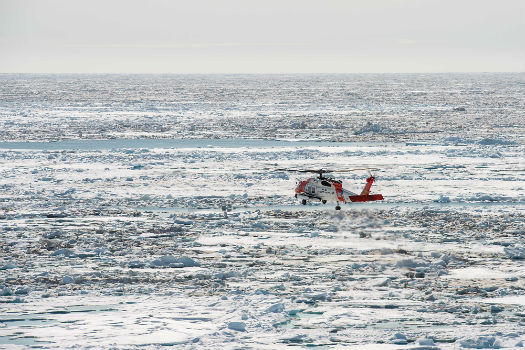
The two helicopters launched nearly simultaneously, flying offshore and just a few hundred feet above the water in a loose formation headed for the coordinates provided by the UAV. And, in both scenarios, the crews quickly located the targets — they had drifted a significant distance and become trapped among the floating ice.
Recovering the targets involved each helicopter taking turns deploying rescue swimmers by hoist into the frigid water, followed by a simulated rescue. The UAVs provided oversight of the manned assets as they conducted the rescues.
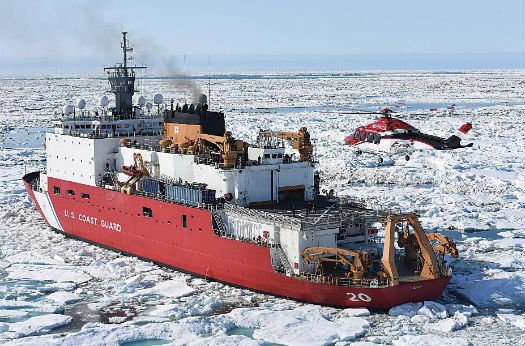
Following the mission, the helicopter pilots spoke positively about working with the UAVs in such a controlled setting. “I think they’re great,” said Merriman. “They save us all kinds of time and money. I’ve been on search flights where you’re out there for three or four bags of gas. If they can send a UAV that can be out there for hours and then tell us where to go, that’s a moneymaker right there.”
However, looking ahead, there is a degree of concern among SAR pilots in taking advantage of the UAV’s capability to be controlled from great distances.

“Operating with an autonomous object offers a unique set of challenges,” said Plunkett. “[What] made us feel comfortable operating with the drone was knowing there was a controller on station that was able to tell me in real time the drone’s location and altitude, so we could keep our vertical separation. As soon as you say the person controlling that vehicle may not be co-located and be potentially hundreds of miles away, how do you provide that separation and mitigate that risk? I think those are some of the solutions that are going to take time and effort and some buy-in from everyone across the board.”
Paul White, Era’s senior vice president, commercial, said offshore search-and-rescue missions are challenging in and of themselves, but with the added complexity and scope of Arctic operations, the stakes are even higher. “Participating in this cutting-edge demonstration not only gave us the opportunity to strengthen our partnerships with the North Slope Borough and the U.S. Coast Guard, it afforded us another opportunity to demonstrate our ability to successfully execute complex SAR missions in a region where interagency support and operation is critical.”





